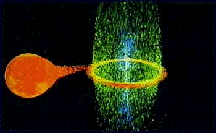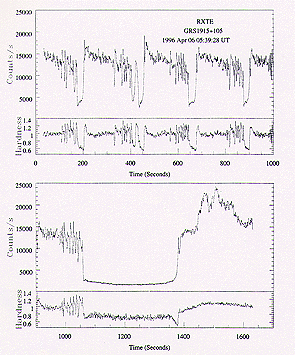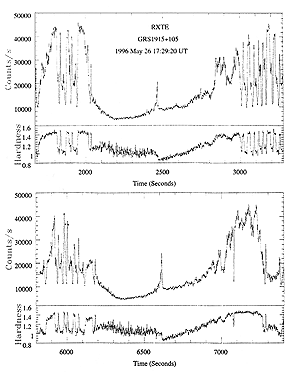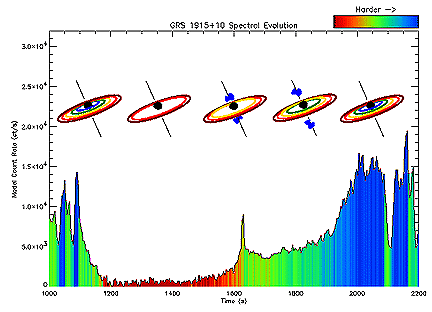RXTE Discoveries
The Mystery of the Disappearing Accretion Disk - January 16, 1998
By uniting multiwavelength observations of black hole GRS 1915+105, scientists were able to put together a picture of one of the most unusual objects in space. It seems that every half hour or so GRS 1915+105, throws off the inner portion of the disk of matter that surrounds it, causing a jet that seems to travel at relativistic speeds. This disk of matter, called an accretion disk, re-forms itself after each jet as the black hole pulls in more matter from its companion star.
"The system behaves like the celestial version of Old Faithful," notes Dr. Craig Markwardt, a researcher working at Goddard Space Flight Center. "At fairly regular intervals, the accretion disk is disrupted and a fast moving jet is produced."
 QuickTime Movie (9.2 Mb) |
"This jet is staggeringly more powerful than a geyser," Dr. Jean Swank, RXTE project scientist added. "Every half-hour, the black hole, in the constellation Aquila, throws off the mass equal to that of a 100 trillion ton asteroid at nearly the speed of light approximately 650 million miles per hour). This process clearly requires a lot of energy -- each cycle is equivalent to six trillion times the annual energy consumption of the entire United States."
|
Stephen Eikenberry said, "What is even more amazing is that we are seeing the first clues to the source of matter ejected in the jets - the correlations we discovered indicated that the jet material must come from the inner disk. For years theorists have hypothesized that the jets come from somewhere close to the black hole, but no one has ever actually seen that direct link until now."
The process of discovering this began in 1996 when scientists Jocham Greiner from the Max Planck Institute (MPE) and Edward Morgan and Ronald Remillard from the Massachusetts Institute of Technology (MIT) used RXTE to observe GRS 1915+105. They noticed some very strange patterns in the light curves they got back.
 |
A light curve is merely a graph of the intensity of a source over time. The light curves of GRS 1915+105 show several unusual features. The first is a repeating pattern of brightness "sputters", as Greiner, Morgan, and Remillard call them. The top light curve shows that every 250 seconds or so, the intensity of the source oscillates with increasing amplitude then drops by a factor as large as 4, for a 30-50 second lull, before becoming brighter again. On April 6, 1996, one lull lasted for over 300 seconds; this is shown in the bottom light curve. (Light curve is from Greiner, Morgan, and Remillard, Astrophysical Journal, vol 473, L107-L110)
|
|
Sometimes sharp intensity flares occur during these lulls; twice on May 26 a complex pattern of oscillations that included an 800 second lull interrupted when a sharp flare occurred. Between these episodes of large-amplitude variations in intensity, the intensity varied more regularly with 20 mHz to 67 Hz quasi-periodic oscillations (QPOs). The QPO reoccurring at 67 Hz may be a clue to the mass and rotation of this black hole binary system. (Light curve is from Greiner, Morgan, and Remillard, Astrophysical Journal, vol 473, L107-L110)
|

|
In the December of 1996 issue of the Astrophysical Journal, Greiner, Morgan, and Remillard suggested that the strongly variable X-ray emission from GRS 1915+105 could be related to the inner part of the black hole's accretion disk. If this relationship is true, then the lulls correspond to some sort of drastic change in the state of this inner accretion disk. Interestingly enough, the observed large-amplitude intensity variations were found to coincide with observed radio flares.
Scientists had previously known that GRS 1915+105 was an unusual source because, among other things, it is known to have superluminal radio jets. This means that both geometry and relativity conspire to make it look like these jets are moving faster than the speed of light! Several questions remained. Were these radio flares associated with the superluminal jets? Were either of these related to the odd accretion disk behavior?
At the January 1998 American Astronomical Society (AAS) meeting, a paper by Stephen Eikenberry, Keith Matthews, and Robert Nelson of the California Institute of Technology (CalTech), and Morgan and Remillard of MIT revealed that they had arranged for simultaneous observations of GRS 1915+105 using both RXTE and Palomar to take measurements in the X-ray and infrared (IR), respectively. They found that this source exhibited quasi-regular flares about every half-hour that are visible in both the X-ray and IR energy bands. Because these flares, which are staggered, occur regularly and at a constant time interval with respect to each other, it seems that they should be closely linked.
What links the appearance of these flares with the shedding accretion disk is that both the IR and the X-ray flares rise together in intensity, but then "decouple". This means that in X-ray energies, the flare looks like it is going through large-amplitude fast oscillations, but in the IR, the flare has a smoother, more symmetrical decline in energy. This is important because this pattern is consistent with the scenario where relativistic plasma is ejected from the inner accretion disk!
Craig Markwardt, of Goddard Space Flight Center, said that it is possible that these regularly occurring X-ray/IR flares are caused by the same accretion disk phenomenon as the much less frequent superluminal radio jets. However, if we could compare the X-ray/IR flares to puffs of cigarette smoke, then the superluminal jets are like a firehose.
Dr. Markwardt kindly donated a combination diagram/light curve that depicts GRS 1915+105's behavior in a very clear manner.
 |
This light curve, which is very similar to one of the ones above, is color coded for different energies of X-rays. The energy of the X-rays changes very dramatically at around 1200 seconds and again at 1600 seconds. At 1200 seconds, the intensity of X-rays falls. This is conjectured to be when the inner accretion disk disappears. At 1600 seconds, an intensity flare appears. It is this flare which seems to be the trigger point for the jets of matter away from the black hole. This seems to occur regularly on a short timescale, leaving visible traces in the X-ray and IR. If the source is examined on a longer timescale though, larger superluminal jets appear at the same trigger point, just much less often than the smaller ones. After the flare, we can see the inner accretion disk fill itself in again. This can be seen in the small diagram above the light curve, each phase lined up with the relevant section of the light curve below.
Edward Morgan, of MIT, has made a sound file of the black hole shedding its inner accretion disk. To listen to it, please follow the link below.


